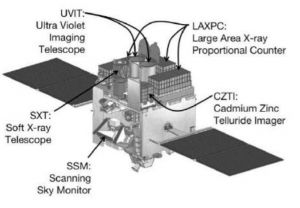“2016年IOAA理论第12题-Astrosat(Discarded)”的版本间的差异
来自astro-init
(创建页面,内容为“{{需要解答}} ==英文题目== '''(T12) AstroSat''' India astronomy satellite, AstroSat, launched in September 2015, has five different instruments. 文件:IO…”) |
|||
| 第10行: | 第10行: | ||
same direction and observe in X-ray wavelengths. The details of these instruments are given in the table | same direction and observe in X-ray wavelengths. The details of these instruments are given in the table | ||
below. | below. | ||
| − | + | {| class="wikitable" | |
| + | |+ | ||
| + | !Instrument | ||
| + | !Band [keV] | ||
| + | !Collecting Area [m2 ] | ||
| + | !Effective Photon Detection Efficiency | ||
| + | !Saturation level [counts] | ||
| + | !No. of Pixels | ||
| + | |- | ||
| + | |SXT | ||
| + | |0.3-80 | ||
| + | |0.067 | ||
| + | |60% | ||
| + | |1500(total) | ||
| + | |512x512 | ||
| + | |- | ||
| + | |LAXPC | ||
| + | |3-80 | ||
| + | |1.5 | ||
| + | |40% | ||
| + | |50000 (in any one counter) or 200000 (total) | ||
| + | | --- | ||
| + | |- | ||
| + | |CZTI | ||
| + | |10-150 | ||
| + | |0.09 | ||
| + | |50% | ||
| + | | --- | ||
| + | |4 x 4096 | ||
| + | |} | ||
[[分类:]] | [[分类:]] | ||
2019年9月11日 (三) 18:58的版本
本题目目前没有解答。要不要你来试试! |
|
英文题目
(T12) AstroSat
India astronomy satellite, AstroSat, launched in September 2015, has five different instruments.
In this question, we will discuss three of these instruments (SXT, LAXPC, CZTI), which point in the same direction and observe in X-ray wavelengths. The details of these instruments are given in the table below.
| Instrument | Band [keV] | Collecting Area [m2 ] | Effective Photon Detection Efficiency | Saturation level [counts] | No. of Pixels |
|---|---|---|---|---|---|
| SXT | 0.3-80 | 0.067 | 60% | 1500(total) | 512x512 |
| LAXPC | 3-80 | 1.5 | 40% | 50000 (in any one counter) or 200000 (total) | --- |
| CZTI | 10-150 | 0.09 | 50% | --- | 4 x 4096 |
[[分类:]]

